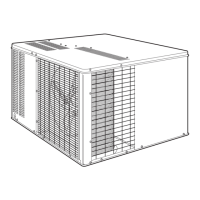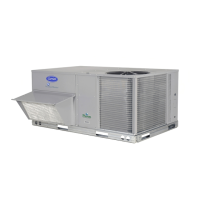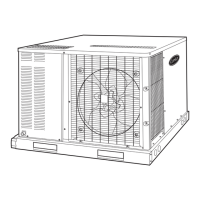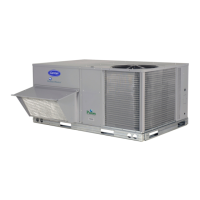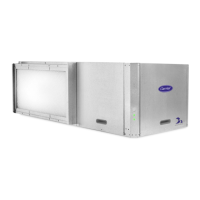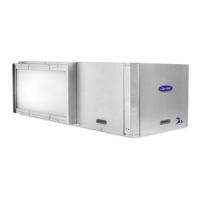Do you have a question about the Carrier 50HQ and is the answer not in the manual?
Essential safety guidelines for installation and servicing personnel.
Unpacking, inspection, and initial site requirements for unit installation.
Key system requirements including codes, water source, space, and mounting.
Connecting the supply air ductwork to the unit's supply air opening.
Guidelines for sizing, transitions, flexibility, and insulation of ductwork.
Connecting water supply and return lines, including valve installation.
Procedure for installing the optional suspension package for ceiling mounting.
Field wiring requirements, power leads, ground connection, and unit transformer.
Adjusting the fan motor speed for optimal air quantity based on unit requirements.
Critical water flow rates and temperature ranges for efficient unit operation.
Control settings, safety devices, and operational checks for unit start-up.
Specific operational details for single-phase compressors, including PTC devices.
Procedures for checking and adjusting refrigerant charge for optimal system performance.
Understanding high-pressure switches and freeze-up protection mechanisms.
Visual representation of refrigerant and water flow in cooling and heating cycles.
Method and charts for determining correct refrigerant charge during cooling operation.
Charts and procedures for verifying system operation and refrigerant charge in heating mode.
Step-by-step guide for using the Chargemaster device for refrigerant charging.
Using specific charts with the Chargemaster for accurate system charging.
Data on compressor models, oil recharge, and specifications.
Detailed steps for removing and installing a compressor, including safety precautions.
Guidelines for lubricating fan motor bearings and cleaning coils/condensate pans.
Procedures for removing and servicing the indoor blower assembly and fan motor.
Instructions for replacing air filters and cleaning the heat exchanger.
Diagnosing issues when the unit does not run or the compressor fails to operate.
Troubleshooting low water temperature cutouts, high-pressure cutouts, and unit cycling.
Addressing insufficient cooling/heating due to airflow, refrigerant charge, or system faults.
Identifying and correcting sources of noise from the compressor, blower, contactors, or piping.
Essential safety guidelines for installation and servicing personnel.
Unpacking, inspection, and initial site requirements for unit installation.
Key system requirements including codes, water source, space, and mounting.
Connecting the supply air ductwork to the unit's supply air opening.
Guidelines for sizing, transitions, flexibility, and insulation of ductwork.
Connecting water supply and return lines, including valve installation.
Procedure for installing the optional suspension package for ceiling mounting.
Field wiring requirements, power leads, ground connection, and unit transformer.
Adjusting the fan motor speed for optimal air quantity based on unit requirements.
Critical water flow rates and temperature ranges for efficient unit operation.
Control settings, safety devices, and operational checks for unit start-up.
Specific operational details for single-phase compressors, including PTC devices.
Procedures for checking and adjusting refrigerant charge for optimal system performance.
Understanding high-pressure switches and freeze-up protection mechanisms.
Visual representation of refrigerant and water flow in cooling and heating cycles.
Method and charts for determining correct refrigerant charge during cooling operation.
Charts and procedures for verifying system operation and refrigerant charge in heating mode.
Step-by-step guide for using the Chargemaster device for refrigerant charging.
Using specific charts with the Chargemaster for accurate system charging.
Data on compressor models, oil recharge, and specifications.
Detailed steps for removing and installing a compressor, including safety precautions.
Guidelines for lubricating fan motor bearings and cleaning coils/condensate pans.
Procedures for removing and servicing the indoor blower assembly and fan motor.
Instructions for replacing air filters and cleaning the heat exchanger.
Diagnosing issues when the unit does not run or the compressor fails to operate.
Troubleshooting low water temperature cutouts, high-pressure cutouts, and unit cycling.
Addressing insufficient cooling/heating due to airflow, refrigerant charge, or system faults.
Identifying and correcting sources of noise from the compressor, blower, contactors, or piping.
| Model Number | 50HQ |
|---|---|
| Category | Heat Pump |
| Refrigerant | R-410A |
| Voltage | 208/230V |
| Phase | 1 |
| Sound Level (Outdoor Unit) | 72 dB |
